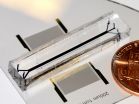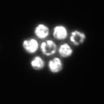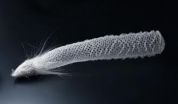INFORMATION:
Other researchers working on this project include Peng Li, postdoctoral fellow; Zhangming Mao, graduate student; Yuchan Chen, graduate student; and Po-Hsun Huang, graduate student, all in engineering science and mechanics at Penn State. Also on the project were Lanlan Zhou, former graduate student in Hematology-Oncology, Penn State Hershey Cancer Institute; Wafik S. El-Deiry, former professor of medicine, Penn State College of Medicine; Joseph J. Drabick, professor of medicine, Penn State College of Medicine; Cristina I. Truica, director, Breast Medical Oncology, Penn State Hershey Cancer Institute and Zhangli Peng, postdoctoral fellow at MIT now assistant professor of aerospace and mechanical engineering, University of Notre Dame.
The National Institutes of Health and the National Science Foundation supported this work.
Sound separates cancer cells from blood samples
2015-04-06
(Press-News.org) Separating circulating cancer cells from blood cells for diagnostic, prognostic and treatment purposes may become much easier using an acoustic separation method and an inexpensive, disposable chip, according to a team of engineers.
"Looking for circulating tumor cells in a blood sample is like looking for a needle in a haystack," said Tony Jun Huang, professor of engineering science and mechanics. "Typically, the CTCs are about one in every one billion blood cells in the sample."
Existing methods of separation use tumor-specific antibodies to bind with the cancer cells and isolate them, but require that the appropriate antibodies be known in advance. Other methods rely on size, deformability or electrical properties. Unlike conventional separation methods that centrifuge for 10 minutes at 3000 revolutions per minute, surface acoustic waves can separate cells in a much gentler way with a simple, low-cost device.
Acoustic-based separations are potentially important because they are non-invasive and do not alter or damage cells. However, in order to be effective for clinical use, they also need to be rapidly and easily applicable.
"In order to significantly increase the throughput for capturing those rare CTCs, device design has to be optimized for much higher flow rates and longer acoustic working length," said Ming Dao, principal research scientist, materials science and engineering, Massachusetts Institute of Technology. "With an integrated experimental/modeling approach, the new generation of the device has improved cell sorting throughput more than 20 times higher than previously achieved and made it possible for us to work with patient samples."
The researchers worked both experimentally and with models to optimize the separation of CTCs from blood. They used an acoustic-based microfluidic device so that the stream of blood could continuously pass through the device for separation. Using the differential size and weight of the different cells they chose appropriate acoustic pressures that would push the CTCs out of the fluid stream and into a separate channel for collection. They report their results today (Apr. 6) in the Proceedings of the National Academy of Sciences.
Tilted-angle standing surface acoustic waves can separate cells using very small amounts of energy. The power intensity and frequency used in this study are similar to those used in ultrasonic imaging, which has proven to be extremely safe, even for fetuses. Also, each cell experiences the acoustic wave for only a fraction of a second. In addition, cells do not require labeling or surface modification. All these features make the acoustic separation method, termed acoustic tweezers, extremely biocompatible and maximize the potential of CTCs to maintain their functions and native states.
If two sound sources are placed opposite each other and each emits the same wavelength of sound, there will be a location where the opposing sounds cancel each other. Because sound waves have pressure, they can push very small objects, so a cell or nanoparticle will move with the sound wave until it reaches the location where there is no longer lateral movement, in this case, into the fluid stream that moves the separated cells along.
The researchers used two types of human cancer cells to optimize the acoustic separation -- HELA cells and MCF7 cells. These cells are similar in size. They then ran an experiment separating these cells and had a separation rate of more than 83 percent. They then did the separation on other cancer cells, ones for which the device had not been optimized, and again had a separation rate of more than 83 percent.
"Because these devices are intended for use with human blood, they need to be disposable," said Huang. "We are currently figuring out manufacturing and mass production possibilities."
Physicians could use the devices to monitor how patients reacted to chemotherapy, for initial diagnosis and for determining treatment and prognosis.
"This work, involving a highly cross-disciplinary group of medical doctors, engineers, computational biologists, and device experts, has led to the design and development of a label-free platform for identifying and separating CTCs while preserving the integrity of the cell," said Subra Suresh, president, Carnegie Mellon University and part of the research team. "It promises to offer new avenues for basic research into the pathology and metastasis, and for clinical diagnosis of rare tumor cells."
ELSE PRESS RELEASES FROM THIS DATE:
Lead hokes the age
2015-04-06
06.04.2015: Rocks do not loose their memory during Earth history but their true ages might be distorted: even under ultra high-temperature metamorphic conditions exceeding 1200°C zircon maintains its lead content accumulated during radioactive decay of uranium and thorium.
Giga year old zircon crystals still contain lead in form of nanometre size spheres of pure lead. However, the inhomogeneous spatial distribution of the lead spheres might falsify ages determined from high-resolution Pb isotope measurement with ion probe.
Zircon is an ideal mineral for age determination ...
Under the microscope, strong-swimming swamp bacteria spontaneously organize into crystals
2015-04-06
Insects form swarms, fish school, birds flock together. Likewise, one species of bacteria forms dynamic, living crystals, says new research from Rockefeller University. Biophysicists have revealed that fast-swimming, sulfur-eating microbes known as Thiovulum majus can organize themselves into a two-dimensional lattice composed of rotating cells, the first known example of bacteria spontaneously forming such a pattern.
"The regular, repeated arrangement of the microbial cells shares the geometry of atoms within a mineral crystal, but the dynamics are fundamentally different; ...
Study suggests new role for gene in suppressing cancer
2015-04-06
Scientists at The University of Manchester have discovered that a previously known gene also helps cells divide normally and that its absence can cause tumours.
The glucocorticoid receptor (GR) has previously been shown to have a role in cell development, immune response and metabolism. It is found in almost every cell in the body. Many widely used drugs, including prednisolone, act through this protein.
The research from Manchester, to be published in the journal Proceedings of the National Academy of Sciences (PNAS), showed a new role for GR after the scientists ...
Neighborhood stigma affects online transactions, NYU researchers find
2015-04-06
The stigma associated with particular neighborhoods has a direct impact on economic transactions, a team of New York University sociologists has found.
Their study, which appears in the journal Proceedings of the National Academy of Sciences, shows that when sellers are seen as being from an economically disadvantaged neighborhood, they receive fewer responses to advertisements placed in online marketplaces.
"Advertisements identifying the seller as a resident of a lower-income neighborhood received significantly fewer responses than advertisements identifying the ...
Sea sponge anchors are natural models of strength
2015-04-06
PROVIDENCE, R.I. [Brown University] -- Life may seem precarious for the sea sponge known as Venus' flower basket. Tiny, hair-like appendages made essentially of glass are all that hold the creatures to their seafloor homes. But fear not for these creatures of the deep. Those tiny lifelines, called basalia spicules, are fine-tuned for strength, according to new research led by Brown University engineers.
In a paper published in the Proceedings of the National Academy of Sciences, the researchers show that the secret to spicules' strength lies in their remarkable internal ...
Study: Near-death brain signaling accelerates demise of the heart
2015-04-06
ANN ARBOR, Mich. - What happens in the moments just before death is widely believed to be a slowdown of the body's systems as the heart stops beating and blood flow ends.
But a new laboratory study by the University of Michigan Medical School reveals a storm of brain activity that erupts as the heart deteriorates and plays a surprising destabilizing role in heart function.
This near-death brain signaling may be targeted to help cardiac arrest patients survive. Most of the more than 400,000 Americans who experience cardiac arrest at home, at work or in public die without ...
Study reveals Internet-style 'local area networks' in cerebral cortex of rats
2015-04-06
Researchers sketching out a wiring diagram for rat brains -- a field known as "connectomics" -- have discovered that its structure is organized like the Internet.
For years, scientists looking for clues to brain function through its structure focused on what could be seen -- the brain's lobes, grooves and folds. Now, with a more comprehensive picture of how neurons connect to one another, they've discovered local networks of neurons nested into one another like shells.
"The cerebral cortex is like a mini-Internet," said Larry Swanson, professor at the USC Dornsife College ...
NIH-funded scientists identify receptor for asthma-associated virus
2015-04-06
Scientists funded by the National Institute of Allergy and Infectious Diseases (NIAID), part of the National Institutes of Health, have identified a cellular receptor for rhinovirus C, a cold-causing virus that is strongly associated with severe asthma attacks. A variant in the gene for this receptor previously had been linked to asthma in genetic studies, but the potential role of the receptor, called CDHR3, in asthma was unknown. The new findings help clarify the function of CDHR3 and point to a novel target for the development of prevention and treatment strategies against ...
Computers that mimic the function of the brain
2015-04-06
Researchers are always searching for improved technologies, but the most efficient computer possible already exists. It can learn and adapt without needing to be programmed or updated. It has nearly limitless memory, is difficult to crash, and works at extremely fast speeds. It's not a Mac or a PC; it's the human brain. And scientists around the world want to mimic its abilities.
Both academic and industrial laboratories are working to develop computers that operate more like the human brain. Instead of operating like a conventional, digital system, these new devices ...
Breastfeeding women and sex: Higher sex drive or relationship management?
2015-04-06
New mothers in the Philippines spend more time in the bedroom with their partner in the first few weeks after giving birth than they did before they became pregnant. This might be a type of survival strategy to keep the relationships with the fathers of their new babies alive and well, to ensure continued support for their offspring. So says Michelle Escasa-Dorne of the University of Colorado in the US, after studying how women from a society with a low divorce rate such as the Philippines adapt to being both mothers and lovers. The study appears in Springer's journal Human ...



